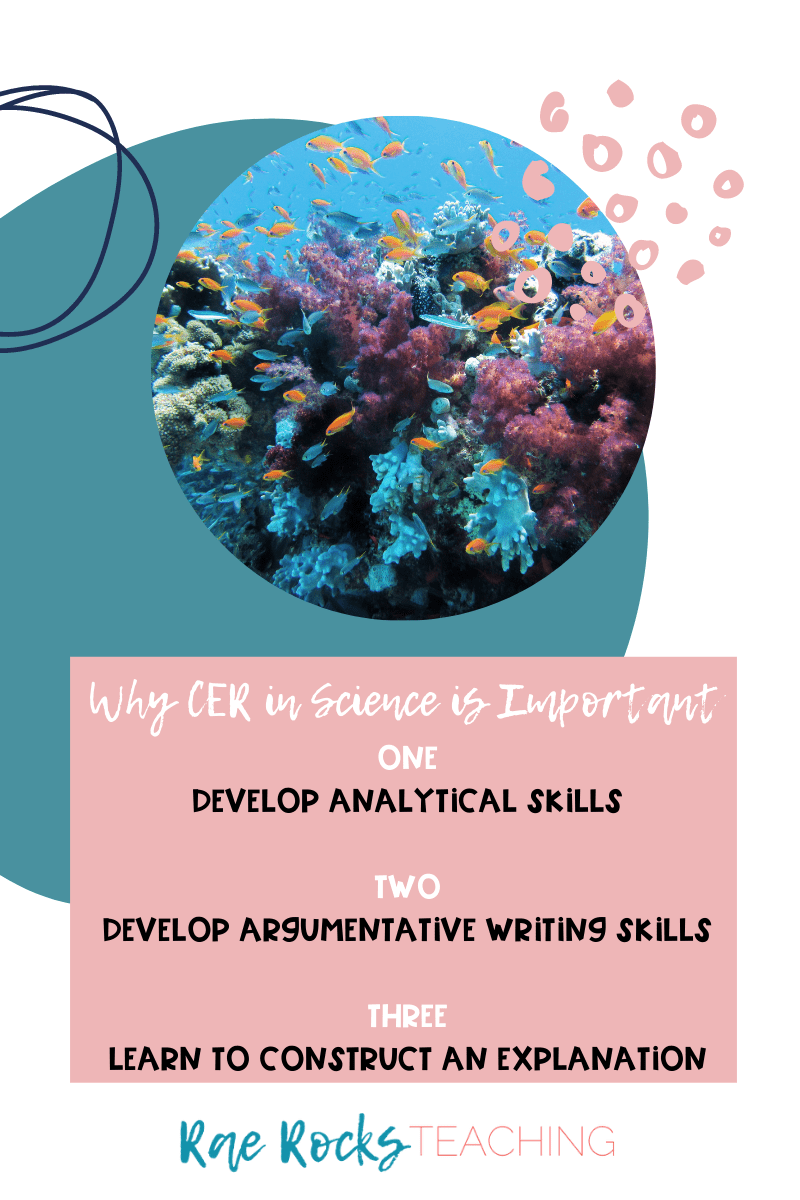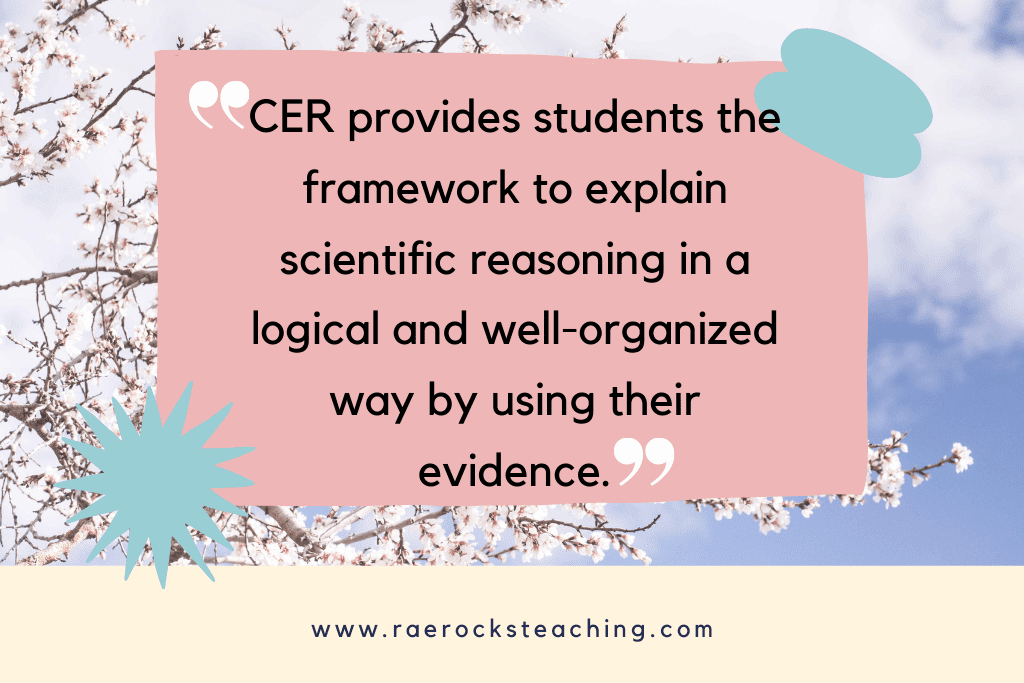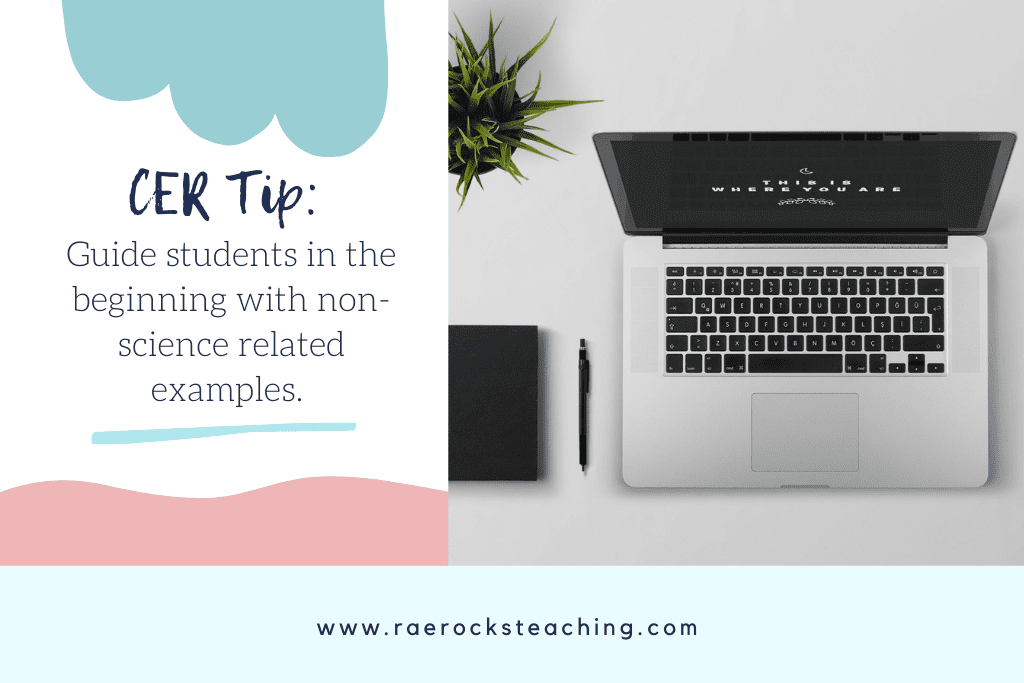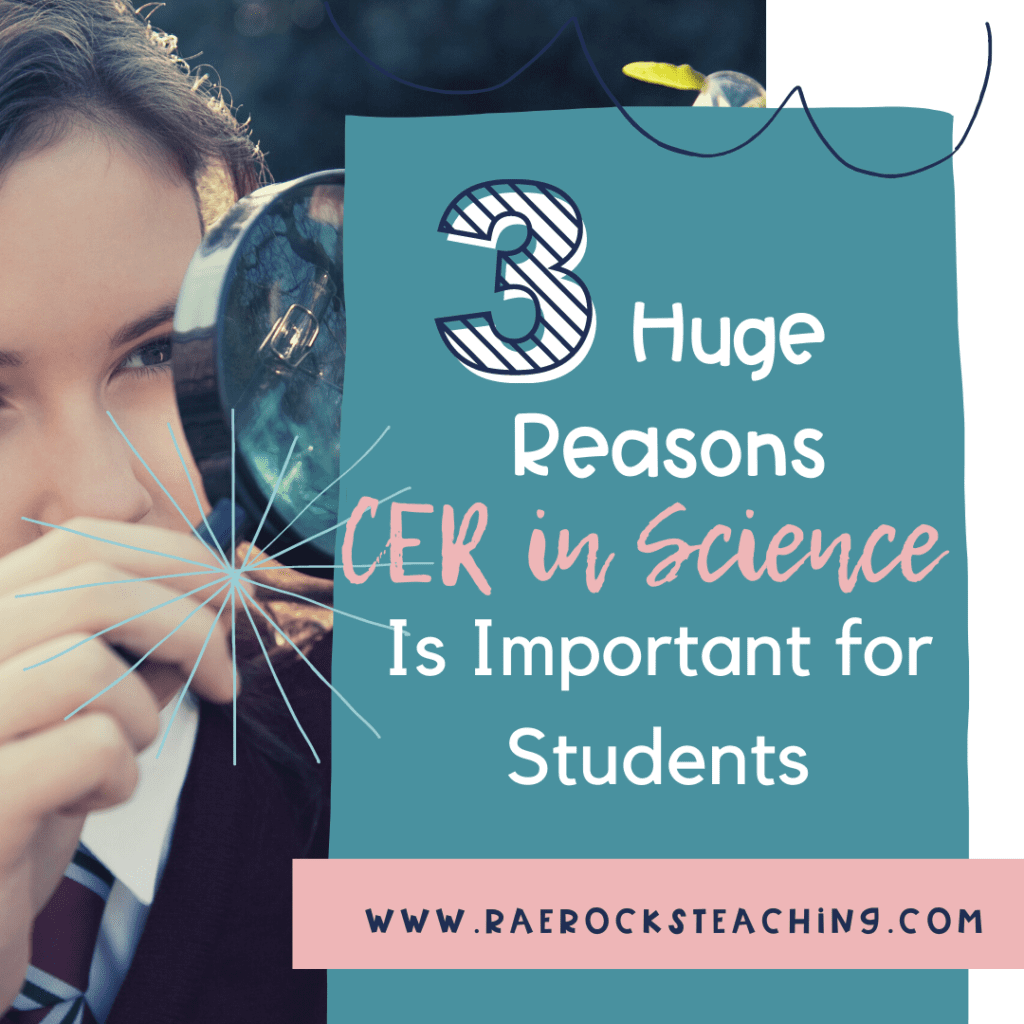What does CER stand for in Science?
CER starts with a question posed by a teacher or a problem. There are many ways to use CER in science, but it can also be applied to everyday scenarios. In this post I’ll explain why CER is so important for you to include in your lesson plans. First, let’s discuss what CER stands for in science.
The C refers to a claim, which is a statement that answers the question. This should be a one-sentence answer to the question you are investigating. A claim is not a fact, but rather should state a point of view that will be investigated. It should answer what you can conclude and should not start with yes or no.
The E refers to the data used to support the claim. Data that does not support the claim should be left out. This data could be qualitative which is anything not numerical, it could be quantitative which includes numerical data, or it could be a combination of both. Evidence should be sufficient enough to support the claim.
The R refers to an explanation of “why and how” the evidence supports the claim. This ties the claim and evidence together The reasoning should provide a rationale for why the evidence is important to the claim. It should also have at least one scientific principle that is important to both the claim and evidence.

-
Save
Example CER Format Science
Let’s say that you cannot find your cell phone. You ask yourself, “Where is my phone?’. This is the problem you are going to investigate. You start with a claim such as “My phone must be in my car.” You go to your car and you do not find it. The evidence is that you looked in your vehicle and it is nowhere to be found. Your reasoning is that your cell phone is not in your car because the evidence shows it is not there.
You then, change your claim to “My cell phone must be in my purse.” You go to look in your purse, and voila there it is! Your evidence supports your claim because you found your cell phone in your purse. Your reasoning is that your cell phone was found in your purse because when you went to search there, you found it in the place you claimed it was.
CER in My Classroom
I have to be transparent and tell you that I have not always been such an advocate for using CER in science. It wasn’t until a few years ago that I realized what a CER was and how to even use it. I had transferred to a new school and the Biology teachers were all implementing CER in science class. Since it was very new to me, I did some research of my own.
I had NO IDEA how important it was to implement CER into the science classroom. I felt like I had been letting my past students down by not doing these all along. However, I got myself together and started right away with my new student. We started off slow and I modeled some examples, then we slowly moved into more advanced problems. What I found was that students became better equipped in explaining “what and how” things happened in labs.
Reasons why CER in Science is Important
ONE | Develop Analytical Skills
Students need to learn deeper skills of inquiry in order to be academically successful in the real world and by using CER in the classroom, you are teaching your students to do exactly this. Those students who are analytical thinkers are capable of inferring cause and effect, analyzing data from their investigations, and interpreting those results. I have found that students that that use CER in their classes develop the skills to provide coherent explanations about their investigations.
TWO | Develop Argumentative Writing Skills
To say something is so doesn’t make it a reality. All scientific phenomenon requires an explanation. By practicing CER in science, students begin to develop the skill of writing an argument in favor of their claim using evidence to support it. Students are forced to use inquiry skills so they can evaluate the authenticity of any claim that is made. Students will be able to take any claim made and use evidence to either support or refute the claim using their evidence to explain. This requires analytical skills as mentioned above and develops their argumentative writing skills.
THREE | Learn to Construct an Explanation
Constructing an explanation is the hardest for students because they struggle with writing what the data shows. Oftentimes, students say “I don’t know what happened” and the reason is they have not learned how to construct an explanation of what their data shows. This is a skill that must be developed and rehearsed in order to grow.

-
Save
What CER in Science Provides Students
Using CER in Science helps students connect their conclusions to the purpose of the investigation, using their evidence to create reasoning. CER also aligns with the Next Generation Science Standards (NGSS). Students begin to understand the results of an investigation using CER rather than not knowing what the conclusion was. CER provides students the framework to explain scientific reasoning in a logical and well-organized way by using their evidence.

-
Save
Teacher’s Role in Implementing CER in Science
Teachers should start by using non-science-related examples. This allows students to gain a basic understanding of how the process works using easy and relatable examples. Teachers should model the CER process at least 3 times before requiring students to do practice on their own. Students should have a basic working knowledge of the process and how to use it before moving on to more advanced CER activities. When introducing a CER, students tend to work better with graphic organizers. As students grow more confident in their skills, a graphic organizer may no longer be necessary.
It is recommended that CER activities be implemented throughout the entire year (or semester) in order for students to get the maximum benefit. The hope is for teachers in their future classes to implement CER into their curriculum to continue the trend.
Best Practices for using CER in Science
Tip #1: Start with using a non-science example.
Below, I have included a list of GREAT CER examples to get your high school students interested and excited about CER.
Tip #2: Incorporate into labs.
After you have gotten the hang of using CER, now it is time to move into science-related examples. See below for a few examples you could use today!
Tip #3: Be consistent.
With any new skill, consistently practicing is key. Remember your mom telling you “practice makes perfect”? Well, it may not be perfect, but it will surely pay off in the long run.
Tip #4: Start with CER outline
By providing an outline that students can use, it allows them to get into the routine of looking for specific key parts of an argument. Use this CER checklist or this CER graphic organizer from Model Teaching to help guide your students in the process.

-
Save
Non-science Examples of a CER
Doritos Commercial
QUESTION→ What happened to the cat?
Audi “Alien” Commercial
QUESTION→ Is the little girl’s dad an alien?”
Audi “Prom” Commercial
QUESTION→ Did the boy get punched in the face at Prom?
Cheryl’s She Shed
QUESTION→ Did someone burn down her she-shed?
Shamwow
QUESTION→ Can these towels really hold 12x their weight in liquid?
CER Examples Biology/Science Focused
Troglobites
QUESTION→ How did these cave salamanders become blind?
Yellowstone National Park Wolves
QUESTION→ Can wolves change the rivers?
Aspartame
QUESTION→ What are the effects of artificial sweetener use on weight loss and obesity?
Coronavirus
QUESTION→ Are younger children less likely to get infected with the coronavirus?
Hunger and Learning
QUESTION→ What is the effect of dietary restriction on learning?
I hope you have found these examples helpful. I know that one of the main pillars in AP classes, specifically AP Bio is for students to justify their reasoning. By using CER, this starts building those necessary skills needed in order to be able to answer those higher level questions seen in AP Bio. If you have any other examples to share let me know in the comments! I absolutely love sharing with y’all and would love to connect on IG or Facebook. Follow me and send me a DM with what you need more of because I’m here to help!
Want more help with lesson planning? Don’t forget to grab my free lesson planning template to help simplify that area of your teaching as well.
Related Articles
Using the Claim, Evidence, Reasoning (CER) Framework in the Classroom
Claim, Evidence, Reasoning (CER) – Model Teaching
Think Like A Scientist: Using Claim, Evidence, and Reasoning
7 Helpful Tips on How to Blog Like a Boss

-
Save
Share via:









5 Responses